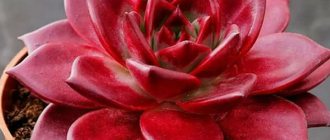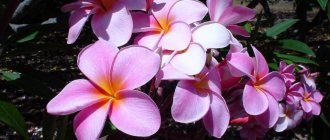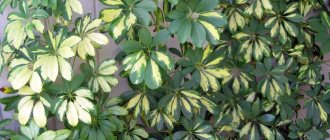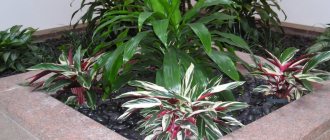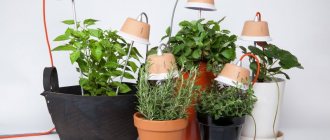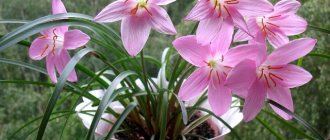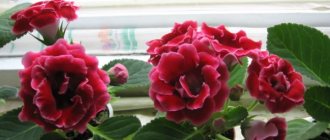- home
- Plant catalog
- Decorative foliage
Reading time: 11 minutes
27363
The Schefflera plant is named after the German botanist Scheffler and is part of the Araliaceae family. Ginseng and ivy are also members of this family. Schefflera is a plant of the tropics and subtropics ; in its homeland it is considered quite aggressive, displacing other crops. But the shefflera flower is very beautiful.
Here it has become a popular houseplant and is recognizable by its palmately compound leaves.
There can be from 5 to 18.
The leaf blade itself, depending on the type, can be narrow, rounded, jagged and wavy.
There is a wide variety of forms that are united under one name. There are several hundred species of it.
- Types of Schefflera Schefflera tree-like, or woody
- Schefflera radiata
- Schefflera eight-leaved
- Schefflera the most graceful
- Scheffler Veitch
- Schefflera palmata
- Schefflera business
- Watering
Types of cheflera
Schefflera Mix, that is, a mixture, is popular among beginning gardeners.
These are the most unpretentious varieties that are readily purchased.
For example, trees with gracefully intertwined trunks are Schefflera Compacta intertwined. Small-sized indoor plants, such as Schefflera Moondrop (Moondrop), remain favorites.
Schefflera arborescens, or woody
Schefflera arboreal in its homeland in Taiwan grows as an evergreen bush, up to 4 meters high. The leaves have from 7 to 9 plates. It is distinguished by the unpretentiousness and beauty of the variegated varieties of this species.
Woody Schefflera is also grown as a bonsai.
A miniature form like Caster looks good. If you have little space, but want to have this particular plant, then the Caster variety is your option. Small in size, 20-30 cm, it will decorate any interior: home or office .
One of the low-growing varieties is also Schefflera Melanie, a graceful variety with small leaves. It does not grow above half a meter.
And Gold Capella, one of the tree-like varieties, is distinguished by its leaves: on a dark green background there are bright golden strokes and spots.
Based on Schefflera woody, the Schefflera Charlotte variety was also recently developed with bright green leaves with white spots, leathery and shiny - a favorite of landscape designers.
Schefflera radiata
Schefflera radiata (or star-leaved) grows in its homeland in Australia as an epiphyte, that is, on trees. It has many aerial roots. In nature, its height is about 12 meters, and the leaf plate can reach 60 cm.
As an indoor plant, the plant grows 60-80 cm, then growth slows down. Radiant varieties are very decorative. Its leaves can be olive, light green in color, and have a finely toothed shape.
Schefflera eight-leaved
Schefflera octophyllum is known in Asian countries. There it grows like a bush or tree, its height is 2-16 meters. The leaves, according to the name, are crowned with a rosette of 8 plates. They are very beautiful, leathery and glossy.
They come in different shapes, depending on the variety: from oval to ellipse, 7-15 cm in length. Sometimes it is called eight-leaved.
Schefflera the most graceful
Grows in Australia and New Zealand. In nature it reaches 2 meters and is distinguished by its lush green mass with a small number of stems. In indoor conditions it is much smaller than other species; in adulthood it has a height of 50 cm.
This elegant species has interestingly shaped leaves: elongated to oval, serrated along the edges. Some varieties have beige edging.
Scheffler Veitch
Known for the reddish hue of its leaves when young. Over time, the leaf changes its color to normal. The leaf shape of this species is very unusual: a wavy leaf plate, jagged along the edge, a real decoration for a home or office.
Veitcha is a rather rare species, and due to its decorative nature it does not linger in flower shops.
Schefflera palmata
Schefflera digitata in its homeland, New Zealand, grows more than 3 meters in height, as a houseplant - 60-70 cm. The leaves are dissected, like all types of schefflera. Depending on the variety, it has from 7 to 14 leaf blades, slightly wavy.
The edge has an interesting shape: from feathery - in youth, to jagged - in adulthood. The most shade-tolerant of them, Schefflera Amate, belongs to this species.
Schefflera business
Its homeland is the forests of Western China. The height in nature is 2-3 meters. The leaves are very beautiful, the plate resembles an oak leaf. As a houseplant - quite squat, about half a meter. Prefers a little shade, otherwise this species is grown in the same way as others.
general description
"Schefflera" is a perennial shrub or tree, in indoor floriculture reaching a height of two and a half meters. Under natural conditions, the tree grows much taller. The shoots of the plant are thin and long. Large leathery leaves grow at the end of strong petioles. Because of the shape of the leaf blades, the plant is called an “umbrella tree .
Indeed, the lobes that make up the leaf, spread out in different directions, resemble an umbrella or a human hand with outstretched fingers. The plate can be divided into four to twelve parts. In an adult specimen, the trunk becomes bare, and the leaves remain only at the top.
In an apartment, the plant does not bloom ; the inflorescences are seen when visiting the botanical garden. They come in different shapes: paniculate, racemose, umbrella-shaped, capitate. Most often they are colored green and white, but some species are scarlet.
The leaves come in different shades: completely green, variegated, with light stains and spots. After the flowering stage is completed, fruits appear on the plant, which are a source of food for insects.
INTERESTING! In England, "Schefflera" is called the "umbrella tree."
Sometimes beginners cannot appreciate young specimens due to their thin stems and huge leaves. But when the plant becomes mature, it reveals itself in its full glory. Often several bushes are planted in one container at once, attaching them to a stick that guides their growth. When the plants grow, a stunning picture opens up.
Sometimes several bushes are planted in one pot in order to form a single plant with a strong trunk. Thin stems intertwine with each other, turning individual shrubs into a beautiful tree.
"Schefflera" is a poisonous plant, so when handling bushes, use caution and safety precautions. It is believed that she is able to take away all the negativity at home.
Lighting
The plant should be protected from direct sunlight in summer , otherwise burns in the form of yellow spots will occur.
And at the same time, the north window is contraindicated.
The best option: southeast or southwest.
When the sun is very strong, you need to move the pot deeper into the room.
In winter, the best option would be a south window.
Advice : Schefflera loves the sun, so a north window is not an acceptable option for her. But it must be protected from direct sunlight.
Secrets of success
Schefflera is a light-loving plant; you should definitely provide shading when exposed to direct sunlight. Regular, abundant watering is recommended, but not overwatering. The optimal temperature for active growth is +18-20°C. In winter, it is recommended to reduce it to +16°C. Warmer conditions lead to leaf shedding. The only exception is the most elegant Schefflera.
From March to August, fertilizing is carried out every 15-20 days. In winter, fertilizing is not allowed.
To get a bushier crown, you need to pinch the growing point on the main stem.
Temperature
Temperature conditions are very important for shefflera. The most comfortable temperature for her will be 15-20°, in winter you need to make sure that the temperature does not fall below 12 degrees , the limit is 10°. Otherwise, the roots begin to rot.
You won’t notice this right away, but over time the process will spread to the above-ground part of the plant. When the stem rots, it becomes soft and the leaves may turn black.
Watering
Watering should be moderate. The soil should not be too damp, but only damp. Temperature and water quality are of great importance. It is better if the container of water sits next to the pot.
Carefully! Watering with cold water promotes root rot.
Fertilizer
The plant is fertilized from March-April to October-November, that is, during the period of active growth. In winter, the plant needs to rest. It is best not to reinvent the wheel, but to feed it with mineral fertilizer 2 times a month or once every two weeks.
Transfer
The Schefflera is replanted as the container is filled with roots.
You can find out by taking out a soaked lump of earth with roots.
There is another option: watch an adult plant, when the roots entwine the ball, the soil dries out faster than usual.
It needs to be replanted into a larger pot. Moisten the soil a little, replant, being careful not to damage the roots, then add more soil. When transplanting, you can use Kornevin.
Schefflera in winter
In winter, shefflera should rest . To prevent her from stretching out, create comfortable conditions for her. Temperature 14-16 degrees, moderate watering, fairly bright lighting and no fertilizing.
Attention! Despite the fact that she loves spraying, in winter it is enough to spray the plant 1-2 times a week.
Care
"Schefflera" refers to plants that zealously love light. South-facing windows are ideal for keeping it in winter and autumn; in summer it is recommended to shade it from the sultry rays of the sun.
Windows with western and eastern orientation are well suited for placing a large plant in a tub.
If there is little light in the apartment, it is worth choosing for breeding with green leaves, because variegated varieties require an abundance of sunlight.
In summer, the flower feels great on the balcony , in a slightly shaded place.
Increased air humidity has a beneficial effect on the flower. “Schefflera” can adapt to room air humidity, but periodic spraying with settled water with soft characteristics will not hurt.
IMPORTANT! If Schefflera is exposed to too high temperatures in summer, the leaves may fall off. In winter, the plant gets rid of leaves in case of excess moisture.
room temperature is quite suitable for maintenance . In cold times, the plant can withstand temperatures of sixteen to eighteen degrees; the minimum thermometer can drop to twelve. Some temperature fluctuations are beneficial.
It is advised to protect it from exposure to drafts ; the influence of cold leads to loss of leaves. It is also not recommended to place a pot of Schefflera near heating devices.
Water with settled water with soft characteristics moderately but regularly. Do not allow the soil in the container with the flower to dry out. Along with excessive dryness, excessive watering is also harmful; this can lead to rotting of the roots.
The flower needs periodic pruning to form a beautiful appearance. Young specimens are replanted every year, and adults - as needed.
Like other plants, “Schefflera” suffers from pests and diseases: mainly aphids, spider mites and scale insects attack it.
If you urgently need an ornamental foliage plant that can decorate a living space, then you should pay attention to “Schefflera”. She is easy to care for and very beautiful.
You can learn more about caring for Schefflera from this article.
Reproduction
Shefflera is propagated mainly in the spring, in March-April. It is not advisable to propagate it in summer, when it is too hot, and in winter, when there is not enough heat and light. There are several types of reproduction:
- To propagate by cuttings, you need to cut off semi-lignified shoots. Then cut them so that each has 2 sheets. Cut them in half, dip the cuttings in Kornevin and plant in slightly damp soil. Cover with a bag until roots appear, ventilate 2 times a day.
- Since Schefflera does not bloom at home, seeds are bought in specialized stores . Plant in a 1:1 mixture of soil and sand, moisten and cover with a lid or bag. To germinate, seeds need a temperature of about 25o. When the second leaf appears, the plant can be transplanted into cups.
- Reproduction in this way is based on the possibility of forming aerial roots. Choose any shoot and make an incision . The bark is removed a little and wrapped in moistened moss, and then polyethylene is fixed on top. This creates a comfortable environment for the formation of new roots.
More details on how to propagate Schefflera from cuttings can be found here:
Schefflera from seeds at home
The procedure should be started in the second half of winter. Seed material is placed in peat to a depth of 3 to 5 centimeters. After planting, the soil must be watered, covered with film and provided with a temperature of + 22 to + 24 degrees.
From time to time, the film must be removed to ventilate and spray the crops. When the first leaves begin to appear, the sprouts are transplanted into separate cups and left in a room at 19-20 degrees.
Diseases and pests
Schefflera can turn yellow for various reasons. If it is attacked by pests (mites, aphids, thrips), then you need to isolate the plant and wash it thoroughly in the shower. Wipe the leaves with a cotton swab and soap. This will give a temporary effect. To fix it, you can spray it with Actellik according to the instructions.
Schefflera can shed its leaves for several reasons:
- in winter, when there is very little light;
- when it is very hot, above 30o;
- when roots rot.
If the first options are not suitable, then we are talking about rotten roots. Take out the plant, inspect the roots, cut off the rotten ones, sprinkle with a large amount of crushed coal.
Schefflera begins to turn black, dark spots appear on its leaves - this means that you didn’t just flood it, but at a low temperature.
It is enough to keep the shefflera in the cold for a day or two and it begins to slowly die.
Immediate help may be to dry the roots by removing the plant from the pot.
You can sprinkle with charcoal, which will absorb some excess moisture.
Carefully! Schefflera does not like drafts!
Transfer
From time to time, Schefflera needs to be replanted. On average, this procedure is performed every 2-3 years. It's time to change the pot when the roots begin to stick out from the top of the soil or from the drainage holes.
The best time to transplant is early spring
First, carefully remove the plant from the pot. If it does not give in, you should lightly water the soil and run a sharp knife along the edge of the container
Afterwards, the old substrate is carefully removed from the roots and inspected for the presence of old, damaged, rotten roots, which will need to be removed at this stage. You can carry out preventive treatment with a fungicide.
The new pot should be only slightly larger than the old one, on average 5 cm in diameter. Drainage is organized from small pebbles or brick chips at the bottom of the tank; it is this that will ensure the removal of excessive amounts of water when watering. The prepared substrate is poured on top of this layer to the middle, a flower is installed, the rest of the soil is added, then lightly pressed on the soil, then watered.
This process can be presented step by step as follows.
- Before replanting, you need to thoroughly water the plant a few days in advance, and apply fertilizer a few weeks in advance so that the flower gains strength and does not experience severe shock.
- First you need to prune dead and diseased stems, which are often the cause of bacterial and fungal diseases. If the crown is too large and you want to make it more compact, you can remove excess shoots. Cut stems by half to encourage new growth.
- Remove the shefflera from the container by turning it upside down, but holding the bush by the trunk at the base of the soil.
- Remove dead or rotten roots with sharp pruners or scissors. The smoother the cut, the better the wound will heal. You can treat it with an activated carbon solution.
- In an already prepared new pot with drainage and the first part of the soil, the shefflera is placed in the center so that the root ball is located at the level of the edges of the container.
Some inexperienced plant growers do not understand why fertilizers should not be applied after replanting, because they help the flower to gain growth and green mass faster. This is precisely the main problem, since after pruning the roots need to develop a full-fledged system again, otherwise they simply will not cope with providing the large plant with the necessary minerals and water.
Sheflera - signs
Signs and superstitions are associated with shefflera. For example, she is considered almost a vampire. Indeed, in nature other plants do not coexist next to it; it is very aggressive.
Darkening on the leaves is attributed to someone's negative energy. It is enough to check the maintenance conditions and the condition of the roots to make sure that this is not the case. After all, even according to Feng Shui, it is recommended to place the plant in the southern part of the office.
Schefflera attracts clients to the office . Let this sign be true. After all, the beauty of a plant, for example, such a variegated species as Arboricola with its tints from pearlescent to yellow, cannot fail to attract attention.
Mr. Summer Resident recommends: Schefflera - a flower for harmony
In esotericism, shefflera is credited with the ability to absorb negative energy. It is believed that its presence in the house brings harmony to the family and prevents disagreements, as well as improves memory and has a beneficial effect on study and work.
There are even several folk signs associated with the condition of the plant:
- darkened leaves mean an excess of negativity in the house;
- falling - a harbinger of illness or financial crisis;
- twisted - to a quarrel;
- unexplained cessation of growth - to failure;
- sudden rapid growth - to a new addition to the family.
How to trim a shefflera - crown formation
Schefflera branches are trimmed to form a more lush and neat crown. It is necessary to remove branches at least 4 internodes with a sharp tool. It is important to choose the right time for such operations. During the dormant period, in winter, the plant does not need to be touched.
Shefflera trimming can be of two types:
- direct formation of the crown - for greater splendor and density of the plant;
- removal of weak, yellowed, dried out, diseased branches.
In order for the plant to begin to branch, you need to cut off the top. Then you will get a lush tree with a dense crown. If you want to form a bush, you need to cut the trunk itself above the bud that has not yet awakened. In this case, the plant will begin to throw out branches throughout the trunk.
Important! Fresh sections should be immediately treated with crushed activated carbon.
The cuttings obtained during the pruning process can easily be used for further propagation.
Trimming rules:
- The cuts must be treated with an antiseptic (activated carbon works well), but if the branches are thick, the cut area will need to be covered.
- An adult plant can be cut off at the root (if necessary) - it will not die, on the contrary, it will produce young shoots and grow back.
- To provoke the growth of side shoots to form a round crown, you need to cut the top of the plant into 6-7 internodes.
- To ensure even branching, you need to pinch the ends of the branches.
- After winter it is necessary to carry out sanitary pruning.
Important! Pruning reduces the plant's immunity, so it needs to be done gradually.
Schefflera is an undemanding plant that is quite easy to give the desired shape. For example, to form a tall tree with a rounded crown, you need to provoke the growth of side shoots, which are then pruned in the shape of a ball. To do this, you need to trim the top of the tree a little, cutting off 6 or 7 internodes.
You can plant several plants in one pot at once - their intertwined trunks combined with a lush green crown will create a very beautiful composition.
To get a fluffy branchy bush, it is necessary to provoke the growth of side shoots at a low height. To do this, you can cut the trunk above the unawakened bud. This technique leads to the fact that the plant begins to produce branches throughout the trunk.
It looks interesting and unusual when several shoots come from the very root, identical in height and density. This can be achieved by pruning an adult plant at the root and then strictly controlling the progress of its growth, pinching or cutting off unnecessary shoots.
